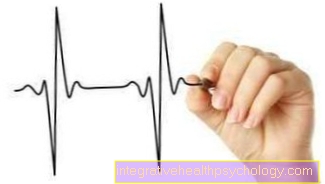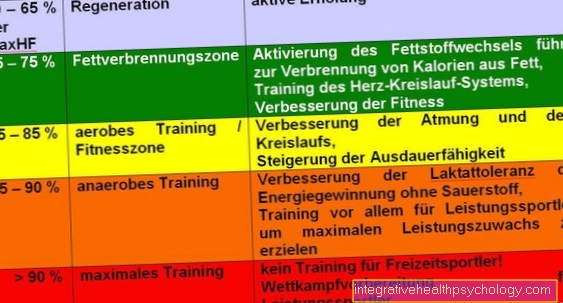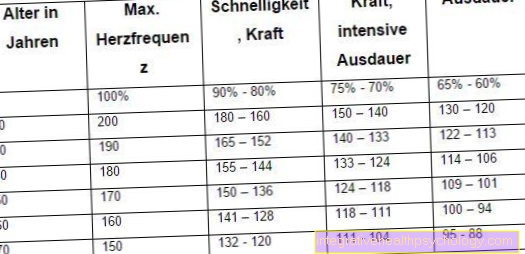Heart rate
Synonyms in the broadest sense
Pulse rate, heart rate, pulse, pulse rate, heart rhythm
definition
The heart rate describes the number of heartbeats per minute and is measured in bpm (beats per minute). It is an important measured variable for the workload of the cardiovascular system, as there is a linear relationship between the heart rate on the one hand and the intensity of exercise on the other.

Definition of resting heart rate
The resting heart rate is the heart rate when the body is at rest. The resting heart rate is determined immediately after you wake up in the morning. It is around 80 beats / min for an adult and decreases as the training progresses.
Definition of maximum heart rate
The maximum pulse is the heart rate that can be achieved under maximum working conditions of the muscles. The maximum heart rate is measured at the highest endurance load (Sprint). As a guideline: 220 minus age. The maximum heart rate is an individual value that differs from person to person. It decreases with age. Thus, the formula here is 220HF / min minus age only to a limited extent. A medical examination is particularly necessary in old age.
Heart rate in the baby
The The heart rate of children is naturally always higher than that of adults. The highest resting heart rate can be determined in infants. In the course of life, this then decreases further and further. On average, heart rates of around 120 beats per minute are normal for babies - a value that would be far too high for adults! At Newborns can even have a resting heart rate of up to 170 beats / min. The reason for this naturally increased heart rate in babies is that it is proportional to body size higher metabolic rate of the infant. Large amounts of oxygen are required for a very active metabolism such as that of small children. In order to get this to the target organs, the heart has to pump large amounts of blood with the help of many contractions. This results in the heart rate appearing to be increased compared to adults.
introduction

By determining the heart rate, the desired training intensity with regard to the selected training goal (e.g. endurance training for fat burning, marathon preparation, etc.) can be maintained. A control of the heart rate using pulse monitors is a prerequisite. In order to achieve long-term success in endurance training, the control of the heart rate is used, especially for beginners, to maintain the desired training intensity. The higher the sporting load, the more oxygen and / or energy is required by the muscles involved. As a result, the heart has to increase its frequency in order to supply the body with sufficient oxygen. The performance of the heart is thus described on the one hand by the heart rate, on the other hand both the stroke volume (the amount of blood that the heart ejects with one beat) and that Cardiac output (the amount of blood the heart ejects in one minute) plays an important role. The more blood the heart pumps into the circulation with one beat, the fewer beats are needed. Thus, competitive athletes have a lower resting heart rate.
How can I measure my heart rate?
To measure the heart rate are suitable different methods. From the very simple, orienting to high-tech devices, there is something for every taste. The simplest (and cheapest) method is manual "Feel the pulse". The easiest way to do this is with a partner, but with a little practice you can also measure yourself on your own body. In order to determine the current heart rate, one looks for a place where the pulse is just palpable. That can Inside of the wrist his (on the side lying towards the thumb runs the so-called Radial arterywhich is usually very easy to touch!) or, for example, a Point on the outside of the neck - roughly in a line below the ear. The common carotid artery (Carotid artery) leads the blood to the head and is easy to find due to its large diameter. Other positions are also possible and conceivable in principle; however, these are the most common measuring points. To feel the pulse you should always use the Index and middle finger of one hand because your own pulse may be reflected too dominantly in the thumb. Once you have safely felt the pulsating blood vessel, you begin to count the beats at the same time with a glance at the clock. All pulsations that can be felt are counted for one minute, resulting in the heart rate in beats per minute.
Are technically more sophisticated Heart rate monitors (with or without chest strap), which take on the time-consuming counting and prove to be very practical, especially during sports. The current heart rate appears regularly and fully automatically on the display of a watch that can be worn relaxed on the wrist or directly on the smartphone. In addition, can the heart rate - especially when it comes to ruling out a possible heart disease or the like - by doctors, for example determined during EKG or other examinations. However, these methods are reserved for certain special cases and are not practical in everyday use.
Heart rate in sport - what should be considered?
Under stress - be it physical or mental - the heart rate increases. This of course also applies to conscious physical activity in the context of sport. The outermost maximum that can be achieved is the so-called maximum heart rate. However, it should not be used as a training guide for everyone. It is only recommended for professional athletes to stimulate their body seldom and only briefly to the highest heart rate. If you want to train but are not a competitive athlete, you should orient yourself on the so-called training pulse, which is significantly lower than the maximum pulse. The training heart rate is to be seen as the ideal target value for improving the condition and thus for strengthening the cardiovascular system. It varies from person to person - depending on age, fitness level, weight, gender, genetics and much more. Untrained can in the much quoted Rule of thumb "180 minus age" find a clue. For more ambitious amateur athletes, we recommend an individual one if interested Performance diagnostics, with which the optimal training heart rate can be determined for different levels of training. In addition to sports medicine specialists, many fitness studios now also offer this type of performance diagnostics
Exercise and heart rate
In one training shows the heart rate Degree of physical exertion on.
The following applies: the higher the heart rate per minute, the higher the load on the athlete. To with one Endurance training to train in the correct heart rate range, it is advisable to train with the help of a Heart rate monitor to be carried out and thus ensure to always be in the optimal load range.
However, one should note that for the calculation of the max. Heart rate the formula only one general validity Has. 220 minus age reflects only an approximate value, which does not have to apply individually.
Controlling a heart rate monitor for endurance training is an effective tool for training control, whereby you should be aware that the maximum heart rate is only for one Exercise test can be determined. In addition, one should not only follow the heart rate monitor, but also be Body feeling incorporate into the training control.
Calculation of the optimal training heart rate
The following formulas are used to determine the optimal heart rate for athletes with different levels of training, as well as various forms of
Endurance training. However, every formula with regard to an HR calculation is only used as a rough guide and is not always correct in practice.
1. When determining the desired training pulse rate, the age must first be taken into account. The age is to be taken into account in relation to the desired cardiovascular load as follows (after Stauzenberg):
Maximum heart rate: 220HF / min - LA
80% utilization: 200HF / min - LA
70% utilization: 180HF / min - LA
50-60% utilization: 160HF / min - LA
2. The Karvonen formula also includes the individual requirements (maximum heart rate and resting heart rate) of the respective athlete in the calculation:
THF = Rest HR + (HRmax - Rest HR) x Int.%
The intensity is to be selected in relation to the desired training goal (see table).
Endurance athletes shouldn't just focus on fixed values. In this way, you can easily train briefly in the anaerobic area with targeted fat burning. The human body adapts better to changing load intensities.
When should you train with which frequency?

Also read our article Heart rate and exercise.
table
For sport beginners it is sufficient to look at a heart rate table at the beginning and to find the right heart rate there depending on the training goal and intensity. The following table shows the maximum heart rates for ages 20, 30, 40, 50, 60 and 70 years old. You can also find the frequencies for the training areas there speed and force (90 - 80% of the max. Force), force and intense endurance (75 - 70% of the max. Force) and the endurance (65 - 60% of the max. Force).

Heart rate limits
The Heart rate is a simple indicator to determine the correct training intensity. With the help of the given tables it can be read off at which heart rate fat is burned.
Unfortunately, the heart rate is dependent on so many factors and varies from person to person. Depending on their level of performance, athletes of the same age have different heart rates. Trained endurance athletes usually achieve Not values as high as untrained. This is due to the fact that the cardiovascular system has become more economical in the training process.
Nevertheless, it makes sense to use the control of the heart rate during training.
Lower heart rate
A high heart rate can Signs of stress or for one poor physical condition be.
In rare cases, however, it can also be a so-called Tachycardia (Racing heart) act. If this is not recognized and treated, it can be Heart attack favor. Therefore you should have a keep a close eye on the high heart rateif it doesn't go away on its own.
People having a heart rate over 70 beats per minute should have start exercisingto train your circulation and thus that too heart. This can also reduce the resting heart rate.
Who has set the goal through a Endurance training lowering his heart rate that should four to five times run about half an hour a week.
It should be noted that the training regularly is carried out and the athlete healthy and balanced diet. You can do the training too convertibleby for example three times 45 minutes runs when you don't have time that often.
When it comes to speed, care should be taken to ensure that the Intensity remains relatively low and you thus in the lower load range trained.
The motto should be: run instead of panting. If you stick to such training and pay attention to the few important things, you can significantly lower your heart rate after six months. The longer an endurance athlete carries out endurance units, the lower the heart rate can be lowered.





























